185. Old Lighthouse Museum
To The Lighthouse
Stonington (Google Maps location)
September 3, 2010
More on my ascent of the lighthouse proper – Right here.
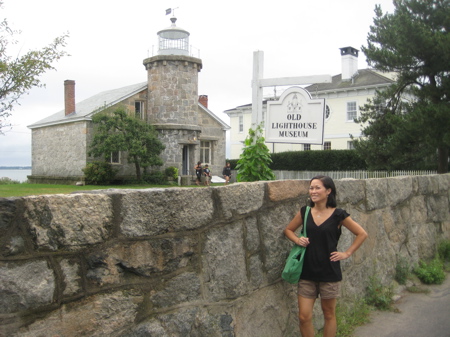 Hurricane Earl.
Hurricane Earl.
Remember that one? You don’t? That’s because it didn’t really happen.
We’d been in Rhode Island all week for vacation (CTMQ family vacation photos here! Woo hoo!) hearing reports of our impending doom. There we were in a bungalow near the beach at the southern end of Point Judith in Narragansett. Surely, we were all going to die – and I was rather upset that the last book I’d ever read would be the horrible To The Lighthouse (CTMQ Top 100 Review here). Reserved to that fate, I woke up and went down to the extreme point and found a bunch of surfers out riding the kicked up waves – which weren’t really all that kicked up. They were certainly choppy and bigger than normal, but really, it just looked like all the storm did was make it nearly impossible to paddle out far enough to catch a wave.
I stopped at Iggy’s on the way back to see how Hoang was holding up, and she seemed okay – especially after I gave her some famous Iggy’s fried dough. “If this is our last day on earth,” I intoned, “we may as well hit up a couple museums.”

“Yes, I was thinking the same thing. That’s exactly how I want to spend my last day on earth,” Hoang replied, without a hint of sarcasm. So we packed up – you know what? We didn’t pack up anything. We just jumped in the car and threw caution to the wind, driving back east towards Connecticut and the beautiful town of Stonington. Always one of my favorite towns in the state.
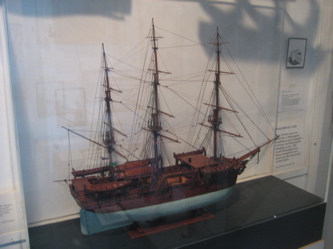 The drive was harrowing. 15 mile an hour gusts blew leaves across the highway distracting me and yeah, it did rain pretty hard, as seen above.
The drive was harrowing. 15 mile an hour gusts blew leaves across the highway distracting me and yeah, it did rain pretty hard, as seen above.
But once we got to Stonington – and more specifically the spit of land that juts out into Narragansett Bay, it was merely drizzling and calm as could be. It was pretty funny to pull into the lot at the end of the point to find all the news vans, hoping to get some footage of destruction. Nope: Flat calm. (Although I’m sure the reports were still as apocalyptic as ever.) The three of us didn’t even wear rain gear or bring an umbrella as we walked up Water Street to the Old Lighthouse Museum. The name is telling the truth: This is indeed an Old museum; since 1927! But the museum is hardly only about the lighthouse. It’s actually (one of) the museum(s) of the Stonington Historical Society and contains a trove of town history items that go far beyond the lighthouse.
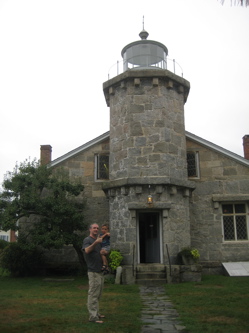 Before we even got to the lighthouse portion, we explored the six rooms of exhibits in the attached building. These rooms exhibit the rich history of Stonington and the nearby coastal region. This is done “ through exhibits depicting the lives of Stonington’s fishermen and farmers, merchants and shipbuilders, pottery makers, blacksmiths and many other trades. Each year a special aspect of Stonington history is featured. One room with a large dollhouse is reserved for items of interest to children and adults.”
Before we even got to the lighthouse portion, we explored the six rooms of exhibits in the attached building. These rooms exhibit the rich history of Stonington and the nearby coastal region. This is done “ through exhibits depicting the lives of Stonington’s fishermen and farmers, merchants and shipbuilders, pottery makers, blacksmiths and many other trades. Each year a special aspect of Stonington history is featured. One room with a large dollhouse is reserved for items of interest to children and adults.”
I, for one am never really interested in dollhouses, but Damian seemed to dig it, so that’s a huge bonus. But that’s upstairs and we’re still downstairs. What’s cool, for me, about these maritime towns’ historical museums is that they contain very different items than the ones up nearer our house. Perhaps if I lived in New London or Stonington, I’d be more excited about the houses in Wethersfield and Farmington. Who knows. But it always seems to me that the quirky folks from history who are tied to the sea are always somehow more interesting. Maybe it’s just me. But then again, when you see the shark-tooth machete in a couple minutes, I think you’ll have to agree with me.
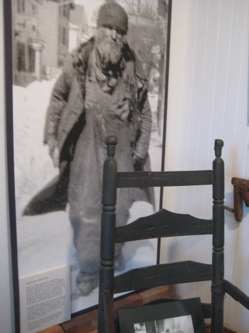 Like ol’ Zebulon Hancox here to the left. Not the most attractive man and certainly doesn’t look well-off. Turns out that the member of a long-time Stonington family wasn’t when he asked some girl to marry him and she refused due to his poverty. So from that point forward, he dedicated his life to making as much money as possible to win the girl’s hand. By the time Zeb was 91, he had amassed $100,000 in savings through fishing, building houses to rent, and never spending a dime on himself. He even made all his own clothes. Of course, by the time he was a hundred-thousandaire, the woman of his dreams was married and dead. But Zeb’s name lives on via Hancox Street in Stonington where the houses he build stood. Oh, and through some of his junk exhibited at the Old Lighthouse Museum of course.
Like ol’ Zebulon Hancox here to the left. Not the most attractive man and certainly doesn’t look well-off. Turns out that the member of a long-time Stonington family wasn’t when he asked some girl to marry him and she refused due to his poverty. So from that point forward, he dedicated his life to making as much money as possible to win the girl’s hand. By the time Zeb was 91, he had amassed $100,000 in savings through fishing, building houses to rent, and never spending a dime on himself. He even made all his own clothes. Of course, by the time he was a hundred-thousandaire, the woman of his dreams was married and dead. But Zeb’s name lives on via Hancox Street in Stonington where the houses he build stood. Oh, and through some of his junk exhibited at the Old Lighthouse Museum of course.
Another fascinating semi-local was John Mason. You may have heard of him, as his name inspire much hatred among certain Nutmeggers. (And yes, certain other citizens still view him as a hero…) I even wrote a page about his stature that has generated a decent amount of traffic and commenting – Check it out here. If you took a couple minutes to read that page, you don’t need to read that Mason was the guy who, as Deputy Governor and therefore commander in chief of Connecticut’s military, led the attack on the Pequots over by the Mystic River in 1637.
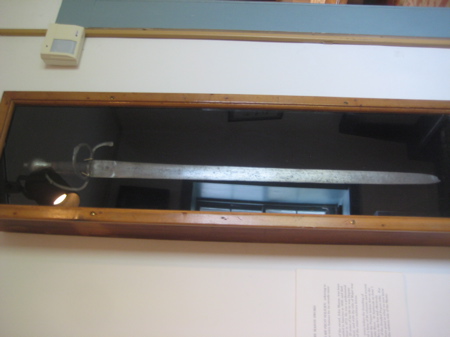
The museum has his sword, which is apparently a very nice and expensive sword, built in Soligen, Germany – one of the top sword cities in the world ever since the Middle Ages. The blurb at this museum takes a somewhat pro-Mason stance but does note the way he won the battle: “At daybreak on June 7 he attacked, setting fire to the fort and effectively destroying the power of the dreaded Pequot tribe. For that service he was given grant to what we now know as Mason’s Island at the mouth of the Mystic River.
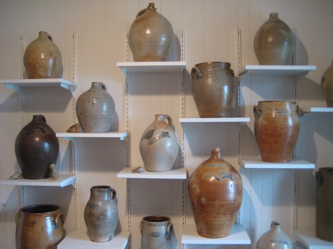 They apparently didn’t have room to mention that Mason burned alive hundreds of women and children with this little fort fire thing and that his statue was fought over for years and years and finally moved far away from the scene of his crime to a more benign place in Windsor. Regardless, it’s pretty cool to see his sword here and I realize that “those were the times” in the late 17th century.
They apparently didn’t have room to mention that Mason burned alive hundreds of women and children with this little fort fire thing and that his statue was fought over for years and years and finally moved far away from the scene of his crime to a more benign place in Windsor. Regardless, it’s pretty cool to see his sword here and I realize that “those were the times” in the late 17th century.
Moving on to less controversial topics, there is a nice display of Stonington pottery and an old “Deacon’s bench” that was used in the Meeting House built on Agreement Hill in 1674. This became the First Congregational Church of Stonington (known as the “Road Church”) and has a pretty cool history of its own.
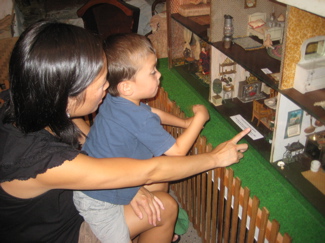 You know how every historic house museum dotes on the same old stuff? Here in Stonington, I learned a new “same old stuff” thing that, according to the explanatory sign, shouldn’t be new to me.
You know how every historic house museum dotes on the same old stuff? Here in Stonington, I learned a new “same old stuff” thing that, according to the explanatory sign, shouldn’t be new to me.
Apparently, well-worn ratty old shoes were placed in the walls of houses back in the day. Here, they say that “shoes have been found in nearly every pre-1850’s house!” That’s totally creepy to me and Hoang would have a conniption if she found an old shoe in a wall. This was done to ward off evil spirits or some such nonsense (NOT that we have progressed at all beyond this notion in the 21st century) and the museum has a shoe that very well might be that of the original “keeper of the Stonington light.”
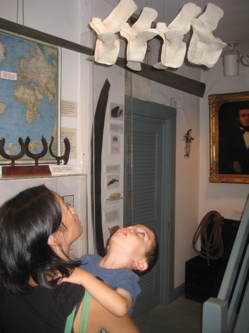 Walking around each smallish exhibit room, we checked out the old farm implements and wood-working tools as well as several ships-in-bottles and even a huge piece of whale vertebra! I enjoyed that.
Walking around each smallish exhibit room, we checked out the old farm implements and wood-working tools as well as several ships-in-bottles and even a huge piece of whale vertebra! I enjoyed that.
Of course there are a bunch of whaling artifacts here, but it’s rare to find a history museum that displays vertebrae and a giant piece of baleen.
But perhaps the top draw here for history buffs are the artifacts relating to the Battle of Stonington in 1814 during the Battle of 1812. The British pretty much had their way with us during that war, and west down I-95 in Essex, they even took over the town for a while – a town which “celebrates” their defeat to this day with their “Loser Day Parade.”
Not so here in Stonington. In fact, quite the opposite happened but no one seems to have an explanation as to why. To this day, the mere fact that Stonington won the battle is a rather vexing mystery.
The facts are that five fully armed British warships descended upon the village and opened up on the town but quit and accepted defeat: For four days in August, the tiny seaport was attacked by the Brits, intent on destroying the town. Every day the village was bombarded with explosive shells, rockets, incendiary missiles and cannonballs. About fifty tons of British ammunition was thrown into the village.
A small handful of Stonington volunteers fought back as best they could, but they were hopelessly outgunned. The British had over 160 cannons, while the village only had two 18-pounder cannons and a brass 6 pounder, as well as some inland farmers wielding rifles. These two 18-pound cannons are still proudly displayed a few blocks away at Canon Square. Here they are:
Captain Thomas Hardy was ordered by Admiral Hotham to attack points along Long Island Sound. Hardy chose Stonington to be a target not because it deserved attack but because it was geographically approachable and would present fewer problems for his ships.
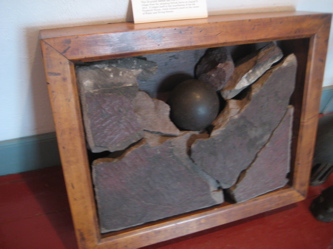 After four days of fighting the British captain suddenly ordered an end to the bombardment and pulled out of Stonington. No one from the town was dead or badly injured. A few British died. The town remained and the mystery remains – why in the world did the British just quit and how in the world did their bombardment not have a worse affect on the town? This is some crazy stuff.
After four days of fighting the British captain suddenly ordered an end to the bombardment and pulled out of Stonington. No one from the town was dead or badly injured. A few British died. The town remained and the mystery remains – why in the world did the British just quit and how in the world did their bombardment not have a worse affect on the town? This is some crazy stuff.
I enjoyed telling Damian to roll the “ball” on the floor but he didn’t so much. There is a small 24-pound cannon ball on display that was shot into Stonington Village from the attacking British forces. It lodged itself in this hearthstone of the old Trumbull House, which formerly stood on the corner of Water and Diving Streets and we get to see it still lodged.
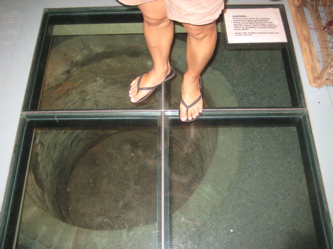 Still more! There’s also a Congreve Rocket on display! This rocket was fired by the British Bomb Ship Terror at the Battle of Stonington. Rockets of this type were used by the British from 1805 to 1815, and were responsible for the “rocket’s red glare” at Fort McHenry in Baltimore (where Francis Scott Key wrote the Star Spangled Banner) a month after they were fired on Stonington. Rad.
Still more! There’s also a Congreve Rocket on display! This rocket was fired by the British Bomb Ship Terror at the Battle of Stonington. Rockets of this type were used by the British from 1805 to 1815, and were responsible for the “rocket’s red glare” at Fort McHenry in Baltimore (where Francis Scott Key wrote the Star Spangled Banner) a month after they were fired on Stonington. Rad.
Time to go upstairs, but not before walking over a glass-covered floor piece that peered down at an old cistern. There was also a well shown like this where the interesting part about that was that instead of collecting the surely brackish groundwater here, it collected rain water from the roof! Pretty clever…
Upstairs the main room is devoted more to Stonington art and its proud shipping history. As cool as some of that is, Damian found his favorite thing in the world (at the time):

Fan fan.
At least we knew he’d be occupied for a good 20 minutes with that fan for us to peruse the exhibits. Let’s pause to show you some of the awesome stuff here:
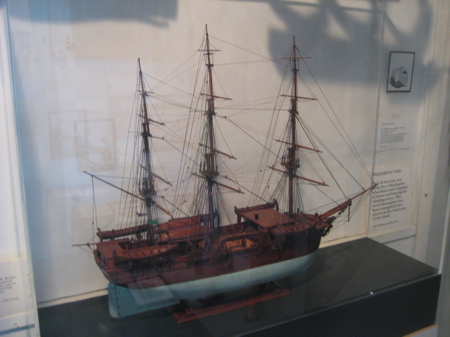
Charles W. Morgan model. The last surviving whaling ship in existence, down at the Mystic Seaport.
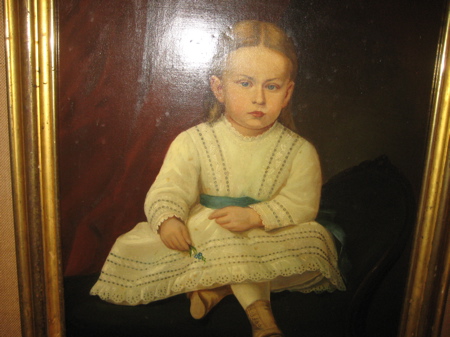
Julian Assange as a 19th century little girl
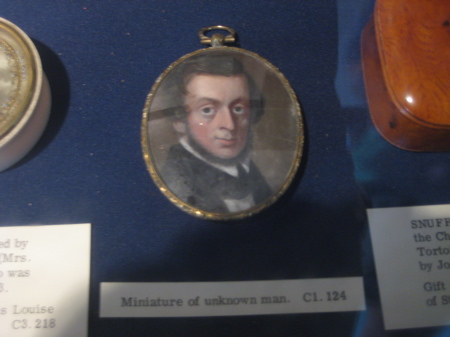
There are known knowns; there are things we know we know. We also know there are known unknowns; that is to say we know there are some things we do not know. But there are also unknown unknowns – there are things we do not know we don’t know.
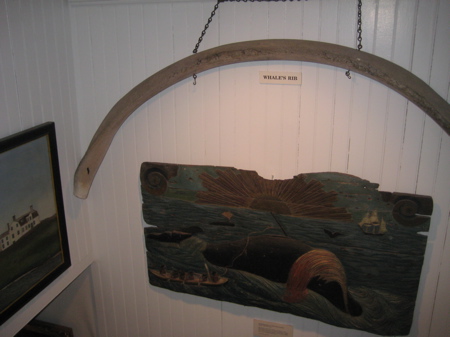
McRib, Supersized (Whale’s rib)
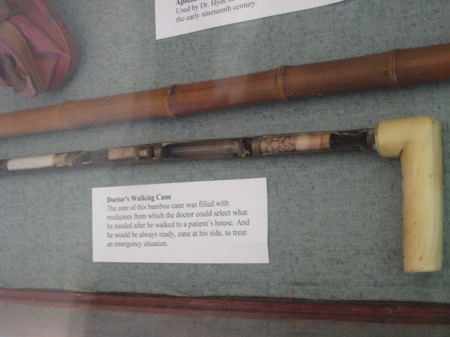
This is a doctor’s cane from back in the day. It’s filled with drugs. Awesome.
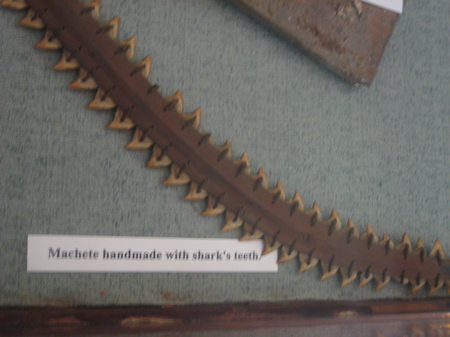
“Machete handmade with shark’s teeth.” I would love to pull this out on that Crocodile Dundee clown.
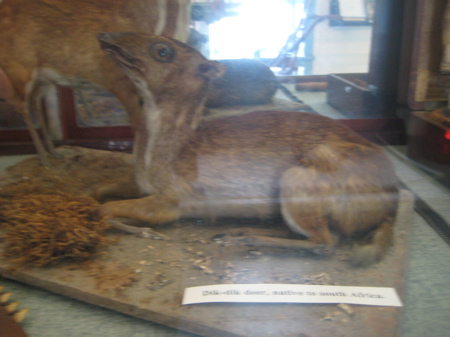
Here’s a dik dik. I don’t know why, but there’s never anything wrong with more dik diks.
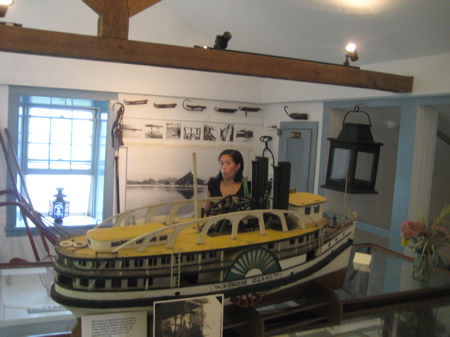
Yeah, I married her.
See, I told you that this place has some really cool stuff on display. As I mentioned earlier, there is a huge dollhouse sort of tucked into an eave that Damian and Hoang enjoyed for a while. When I see them, I think about how little girls these days probably play some sort of “Doll House app” on their iPads and it makes me a little sad I guess.
I spent the time checking out this thing on the left:
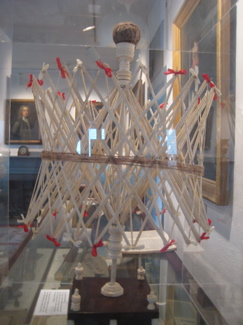
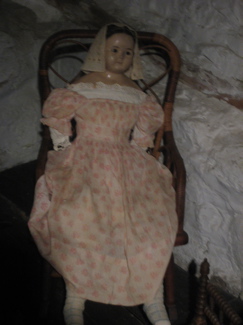
Do you know what that is? That is a Whalebone Swift. Swifts were used to hold skeins of newly spun yarn as it was being wound into balls. The swift revolves to feed out the yarn to the person winding it. The cage is made of whalebone, the clamps of ivory (whale teeth), and tortoise shell is used in the sides of the base in which the swift sits.
As for knowing anything about the creepy doll next to the swift, the less we know the better.
Speaking of dolls and dollhouses and gender-specificish toys and whatnot, did you know that Connecticut’s first women’s college was apparently in Stonington? This, according to a sign at the Old Lighthouse Museum –
“In 1857 The Wadawanuck Hotel…” eh, you know what? Read it yourself:
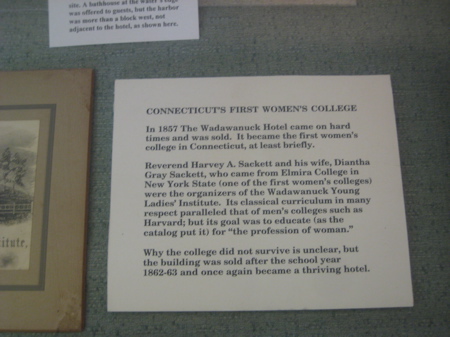
Ok, Damian, we’re done up here. Say bye to your fan. Let’s go over to the lighthouse proper already.
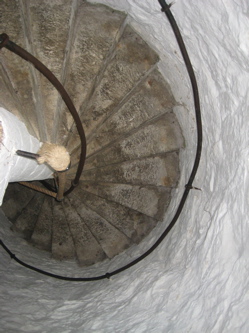 The old lighthouse is attached to the museum building and the stairway up the light tower is very, very skinny. I had to wait for some family to come down before I could venture up, so while I wait, let’s learn a bit about this thing.
The old lighthouse is attached to the museum building and the stairway up the light tower is very, very skinny. I had to wait for some family to come down before I could venture up, so while I wait, let’s learn a bit about this thing.
This lighthouse was once the beacon for the many vessels approaching Stonington’s harbor from Long Island Sound. The original 30-foot stone tower, which was built on the Point in 1823, supported a lantern containing ten oil lamps and parabolic reflectors. Its beacon was visible 12 miles at sea.
During the next few years, however, storms and shore erosion took their toll on the exposed site. In 1840 the structure was dismantled and the materials used to build a new tower and keeper’s dwelling on the present site. The light remained active until 1889 when a beacon was installed on the outer end of a new breakwater protecting the harbor entrance.
Visitors of all ages enjoy climbing the old iron steps of the tower for an exhilarating view in all directions.
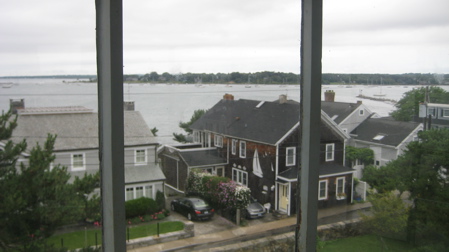
So basically, this lighthouse used to be a couple hundred yards down the spit of land we’re on at “the Point” but it was about to topple into the sea so they dismantled it, moved it inland to this location, used it for 50 more years until it became obsolete due to a breakwater having been built.
As lighthouses go, this one is small and squat. But back in the day, it was perfectly effective and served its purpose well. Of course I, like very red-blooded New Englander white guy, have an affinity for lighthouses and was happy to be at the top of my first one in Connecticut. Oh yeah, to answer your question – I have a list for open lighthouses as well. Don’t be silly.
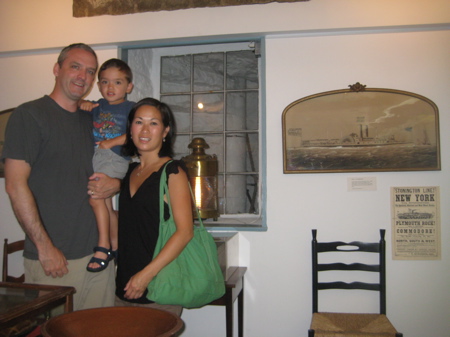
…………………………………………………….
Cost: $9 which also includes the Palmer House Museum as well
Hours: May-Oct 10-6; April & Nov 10-4
Food & Drink? My favorite winery is in Stonington
Children? Yes, there’s enough stuff to keep them happy here
You’ll like it if: Shark-tooth machete? You saw that, right?
You won’t like it if: You are of the Sith
Freebies: None
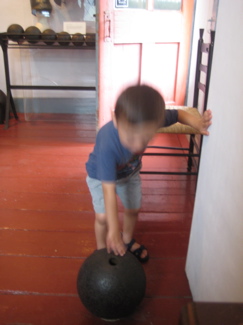
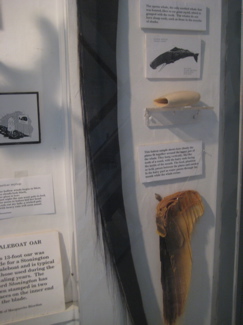
For the Curious:
The Old Lighthouse Museum
What to do in Stonington Borough
Interesting Battle of Stonington article
Battle of Stonington poem
Good Story about the Battle’s flag
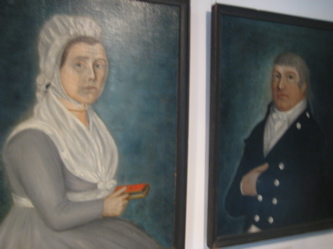
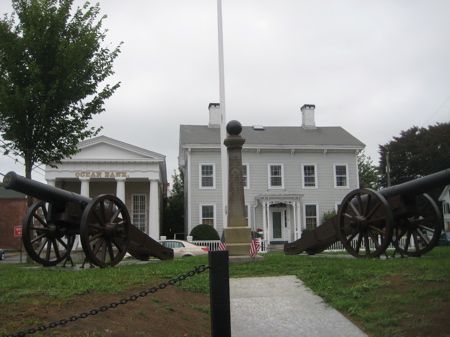






You need a list of creepy dolls, too!
Comment #1 on 01.25.12 at 1:46 pm[...] You can read more about the Old Lighthouse Museum on Connecticut Museum Quest. [...]
Comment #2 on 08.11.12 at 1:04 am